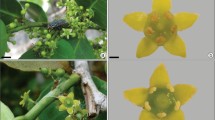Abstract
Under certain conditions inBotrydiopsis alpina stacks of chloroplasts are formed. They consist of up to 8 elements. In contrast to what is known from other algae in zoosporangia of this species and ofHeterococcus caespitosus, stigmata are formed in early developmental stages. They are reproduced together with the chloroplasts, in which they occupy a position at the edge and near the existing or future incision. At the side of the old stigma a new one is formed, and partitioning of the chloroplast between these two leads to their distribution to the daughter chloroplasts. Young daughter cells in the zoosporangia ofBotrydiopsis alpina contain one chloroplast which undergoes a last unequal division giving rise to one astigmate and usually somewhat smaller and to one stigmate chloroplast. In both species the capacity for locomotion may be suppressed, the presumptive zoospores thereby becoming aplanospores. Autospores in the proper sense were not observed. Their development quite generally is different from that of aplanospores (and zoospores), and both types of spores should be distinguished.
Similar content being viewed by others
Literatur
Broady, P. A., 1976: Six new species of terrestrial algae from Signy Island, South Orkney Islands, Antarctica. — Br. Phycol. J.11, 387–405.
Brown, R. M., Bold, H. C., 1964: Phycological Studies V. Comparative Studies of the Algal GeneraTetracystis andChlorococcum. — Univ. Texas Publ. no.6417. — Austin (Texas): University of Texas.
Deason, D. R., Bold, H. C., 1960: Phycological Studies I. Exploratory Studies of Texas Soil Algae. — Univ. Texas Publ. no.6022. — Austin (Texas): University of Texas.
Dodel, A., 1876:Ulothrix zonata. Ihre geschlechtliche und ungeschlechtliche Fortpflanzung, ein Beitrag zur Kenntnis der unteren Grenze des pflanzlichen Sexuallebens. — (Pringsheim) Jahrb. Wiss. Bot.10, 417–550.
Ettl, H., 1978a:Xanthophyceae. — Süßwasserflora von Mitteleuropa3/1. Stuttgart: Gustav Fischer.
, 1978b: ÜberHydrianum viride (Characiaceae, Chlorophyceae), seine Fortpflanzung und Taxonomie. — Pl. Syst. Evol.129, 209–219.
Hibberd, D. J., Leedale, G. F., 1971: Cytology and ultrastructure of theXanthophyceae II. The zoospore and vegetative cell of coccoid forms, with special reference toOphiocytium majus Naegeli. — Br. Phycol. J.6, 1–23.
Pascher, A., 1925:Heterokontae, Phaeophyta, Rhodophyta, Charophyta. — In: Die Süßwasser-Flora Deutschlands, Österreichs und der Schweiz. — Jena: Gustav Fischer.
- 1939: Heterokonten. — Rabenhorsts Kryptogamen-Flora11. — Akad. Verl. Ges.
Pitschmann, H., 1962: Vorarbeiten zu einer Monographie der GattungHeterococcus. — Nova Hedwigia5, 487–531.
Reisigl, H., 1964: Zur Systematik und Ökologie alpiner Bodenalgen. — Österr. Bot. Z.111, 402–499.
Strasburger, E., 1875: Über Zellbildung und Zelltheilung. — Jena: Dabis.
Trenkwalder, H., 1975: Neue Bodenalgen aus Föhrenwäldern im Raum von Brixen (Südtirol). — Ber. Nat.-Med. Ver. Innsbruck62, 7–19.
Tschermak, Elisabeth, 1941: Untersuchungen über die Beziehungen von Pilz und Alge im Flechtenthallus. — Österr. Bot. Z.90, 233–307.
Tschermak-Woess, Elisabeth, 1978: Über die Phycobionten der SektionCystophora vonChaenotheca, insbesondereDictyochloropsis splendida undTrebouxia simplex spec. nova. — Pl. Syst. Ev.129, 185–208.
, 1948: Über zweierlei Typen der sukzedanen Teilung und ein auffallendes Teilungsverhalten des Chromatophors bei einer neuen Protococcale,Myrmecia pyriformis. — Österr. Bot. Z.95, 194–207.
Vischer, W., 1945: Heterokonten aus alpinen Böden, speziell dem schweizerischen Nationalpark. — Erg. Wiss. Unters. Schweiz. Nationalparkes1, 477–524.
Zeitler, Ilse, 1954: Untersuchungen über die Morphologie, Entwicklungsgeschichte und Systematik von Flechtengonidien. — Österr. Bot. Z.101, 453–487.
Author information
Authors and Affiliations
Additional information
Herrn Professor Dr.Lothar Geitler zum 80. Geburtstag in Verehrung gewidmet.
Rights and permissions
About this article
Cite this article
Tschermak-Woess, E. Über Plastidenstapel beiBotrydiopsis alpina sowie Anlage und Vermehrung der Stigmen bei dieser undHeterococcus (Xanthophyceae). Pl Syst Evol 131, 179–192 (1979). https://doi.org/10.1007/BF00984252
Received:
Issue Date:
DOI: https://doi.org/10.1007/BF00984252




